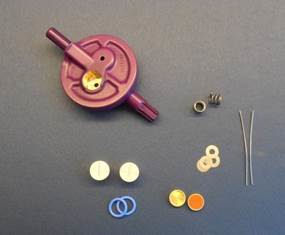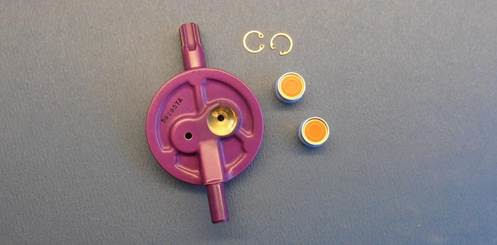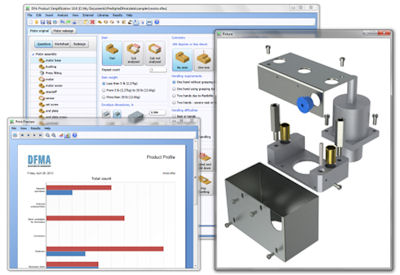Design for Assembly Software Updated
Boothroyd Dewhurst DFA 10 said to deliver faster, easier-to-use analyses for streamlining parts and product assemblies.
Latest News
June 19, 2013
 |  |
| These screen shots display an original, non-DFA assembled item (left) and the 15 individual parts it contains (right). Total assembly time is approximately three minutes. Test time is about 13 minutes. A DFA analysis showed this subassembly as a bottleneck then provided suggested redesign options to improve its manufacturability. Image courtesy of Boothroyd Dewhurst, Inc. | |
DFA Product Simplification, says the company, provides a quantifiable methodology to identify unnecessary parts in an assembly and to determine assembly times and costs. It helps companies achieve their lean and value engineering goals by guiding engineers toward the creation of single, multifunctional components with significantly improved performance-to-cost ratios.
Operationally, DFA prompts engineers to scrutinize each part in a design for structural efficiency and its contribution to overall assembly costs as well as assembly time, including handling procedures. Report and graphing functionality provides techniques to compare different design alternatives and interrogate the design simplification processes. The resulting products are described as “elegant” and “highly economical,” which, in turn, can increase manufacturing throughput and reduce a product’s organizational footprint as it progresses from the design process to the factory floor and, ultimately, to the customer.
“The goal we had while developing DFA 10 was to help users concentrate on the fundamental analysis and redesign of their products and less on navigating the methodology and software interface,” explains Brian Rapoza, R&D manager at Boothroyd Dewhurst, in a press statement.
 This screen shot shows the new DFA-driven subassembly and its individual parts. The butterfly valve assembly no longer requires a separate assembly and test station and is no longer a bottleneck for the top assembly process in the valve. Part count fell from 15 parts to 5 parts. A pressure test is no longer required at the disc assembly stage, dropping operation time from 16 minutes to 90 seconds. Image courtesy of Boothroyd Dewhurst, Inc. |
“Every aspect of analyzing and redesigning a product has been refined to simplify the effort,” Rapoza says. “The software screens and code have been rewritten from the ground up, empowering users with more of the information needed to make important design decisions quickly.”
DFA offers such features as the ability to establish a rating for your product design in terms of its difficulty of assembly as well as the ability to measure a product’s assembly efficiency. These ratings can serve as a basis for the quantitative comparison of design alternatives or against competing products.
Enhancements in DFA 10 highlighted by the developer include:
- Increased efficiency because only the most important DFA questions are asked for each handling and assembly operation.
- A more guided redesign process has been incorporated into the software with suggestions that have been built into the product structure under review.
- The DFA worksheet has been integrated with the structure chart to enable seamless toggling back and forth during an analysis.
- Automatic time estimates for common assembly operations, such as unpackaging of large parts and aligning holes with an awl prior to insertion of a screw or pop-rivet.
- The software automatically estimates acquisition times for parts and tools without requiring additional input.
- A new ability to compile more useful results based on function groupings of parts and operations in a product.
- A new test-view panel in the operations library is said to make it easier and faster to develop customized assembly operations.
- Customized tabular reports can be generated and exported.
- Full “undo” and “redo” features have been added.
 DFA 10 software from Boothroyd Dewhurst guides engineers though a series of questions intended to identify areas for consolidating unnecessary individual parts into multifunctional components and assemblies. The process is said to result in a better quality, higher performing product at reduced cost. This screen shot shows a motor assembly (right) before redesign and a graph (left) showing areas that are open to improvement though product simplification. Image courtesy of Boothroyd Dewhurst, Inc. |
“Fewer parts make for an improved business process,” said Dave Vranson, Advanced Manufacturing Engineer at ITT Aerospace Controls in a testimonial supplied by Boothroyd Dewhurst. “Industry understands the impact of DFA on piece-part cost and quality. It’s well proven. What we as manufacturers are exploring and better appreciating are the benefits that DFA provides once the product is out of design.
“For example, on a recent redesign of a small butterfly valve assembly, our ITT Aerospace engineering team trimmed part count from 15 to 5, operational assembly time from 16 to 1.5 minutes, material cost by seven percent “and overhead by one-half,” said Vranson. “The reduction of overhead on this item will redistribute itself over the entire product line and manufacturing enterprise, allowing us to better invest in future products.”
“The proposed DFA valve redesign also virtually eliminates production rework and has easy field serviceability,” Vranson added. “These are important objectives to our Lean and Value Engineering teams.”
DFA complements Boothroyd Dewhurt’s Design for Manufacture (DFM) software. While DFA software helps reduce a product’s assembly cost, DFM helps design engineers quickly judge the cost of producing the new design and compare these costs with those producing the original assembly. Together, these applications can give engineers an early cost profile of product designs that influence the manufacturing and lifecycle costs before the costs are locked in.
For further details on DFA Product Simplification version 10, click here.
Watch a demo of Design for Assembly.
Download the Design for Assembly brochure.
Learn more about Design for Manufacture (DFM) software.
See why DE’s editors selected DFA Product Simplification version 10as their Pick of the Week.
Sources: Press materials received from the company and additional information gleaned from the company’s website.
Subscribe to our FREE magazine, FREE email newsletters or both!
Latest News
About the Author
Anthony J. Lockwood is Digital Engineering’s founding editor. He is now retired. Contact him via [email protected].
Follow DE





